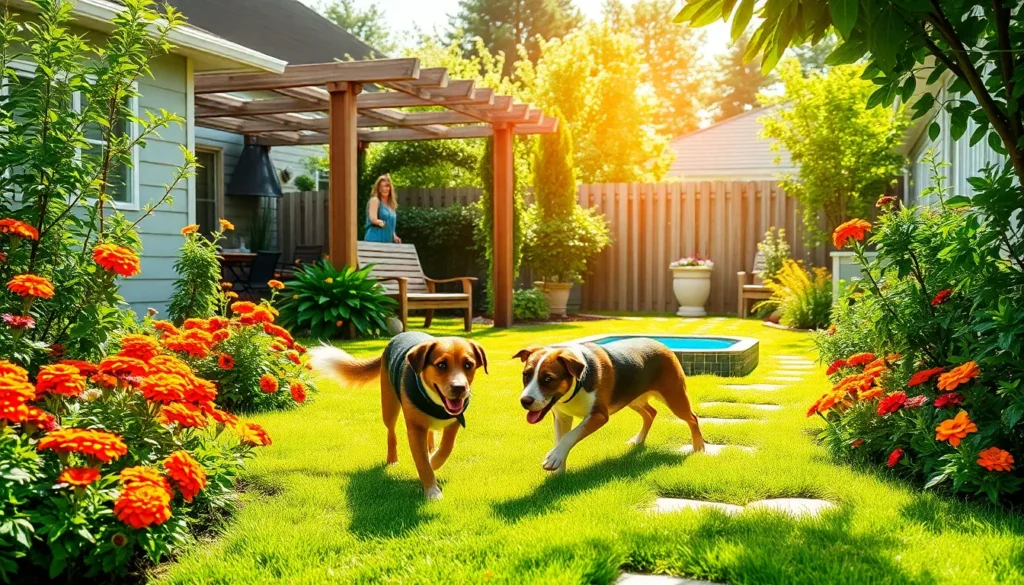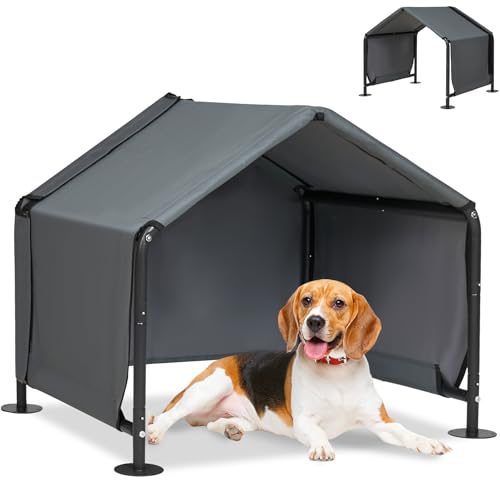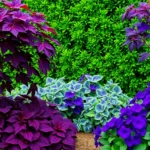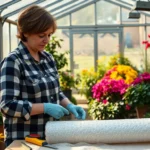We love our furry companions and want them to enjoy every part of our home – including the garden. Creating a dog-friendly outdoor space doesn’t mean sacrificing beauty or functionality. Instead it’s about designing a industry that keeps our pets safe while giving them room to play explore and relax.
A well-planned dog-friendly garden protects our four-legged family members from toxic plants while providing them with captivating features they’ll love. From choosing pet-safe plants to creating designated play areas we can build an outdoor oasis that works for both humans and dogs.
Whether you’re starting from scratch or retrofitting an existing garden we’ll show you how to create a space that’s both stunning and secure. Your pup deserves a backyard paradise and with the right planning you can give them exactly that without compromising your industry dreams.
Create Safe Plant Zones With Non-Toxic Varieties
Plant selection becomes critical when designing spaces where dogs spend time outdoors. We can maintain beautiful landscaping while keeping our furry friends safe from harmful vegetation.
Choose Dog-Safe Flowers and Shrubs
Marigolds offer vibrant colors throughout growing seasons while remaining completely safe for curious canines. These hardy annuals bloom in yellow, orange, and red shades that brighten garden borders without posing health risks.
Sunflowers create dramatic focal points with their towering stems and cheerful faces. Dogs can safely investigate these giants, and fallen seeds provide natural treats during autumn months.
Roses add classic elegance to any garden design when we select thornless varieties. Modern cultivars like ‘Knockout’ roses bloom repeatedly while keeping paws protected from sharp thorns.
Pet-safe shrubs include spiraea, forsythia, and ninebark that provide structure and seasonal interest. These woody plants create natural boundaries while offering dogs safe spaces to explore and rest beneath their branches.
Herbs like basil, cilantro, and parsley serve dual purposes in dog-friendly gardens. We can harvest fresh ingredients for cooking while providing dogs with safe plants to sniff and occasionally nibble.
Avoid Poisonous Plants Like Azaleas and Lilies
Azaleas contain grayanotoxins that cause vomiting, diarrhea, and potentially fatal heart problems in dogs. These popular flowering shrubs should be completely eliminated from areas where pets roam freely.
Lilies pose extreme dangers, particularly to cats, but can also harm dogs when ingested. Easter lilies, tiger lilies, and daylilies all contain compounds that damage kidneys and require immediate veterinary attention.
Sago palms rank among the most toxic plants for dogs, with just one or two seeds causing liver failure. These popular industry plants contain cycasin, making every part of the plant deadly to curious pets.
Oleander produces beautiful flowers but contains cardiac glycosides throughout its leaves, stems, and blooms. Even small amounts can cause irregular heartbeat and breathing difficulties in dogs.
Foxglove creates stunning vertical displays but contains digitalis compounds that affect heart function. We must remove these cottage garden favorites from any space where dogs might investigate or play.
Install Raised Beds for Better Plant Protection
Elevated planters keep valuable plants safely above ground level while preventing dogs from digging or trampling delicate specimens. Cedar, composite, or stone materials create attractive barriers that blend with garden aesthetics.
Height considerations should place beds at least 18 inches tall for small dogs and 24 inches for larger breeds. This elevation discourages jumping while allowing us to tend plants comfortably without bending.
Strategic placement positions raised beds near patios or walkways where we can easily monitor both plants and pets. Corner locations work particularly well for creating defined garden zones that don’t interfere with play areas.
Drainage systems prevent water accumulation that attracts dogs to dig or drink from stagnant pools. We install gravel layers beneath soil and ensure proper drainage holes prevent root rot and standing water issues.
Border materials like decorative stones or low fencing around raised bed bases create clear visual boundaries. These additions help train dogs to recognize off-limits areas while maintaining clean garden lines.
Design Durable Pathways That Withstand Paw Traffic
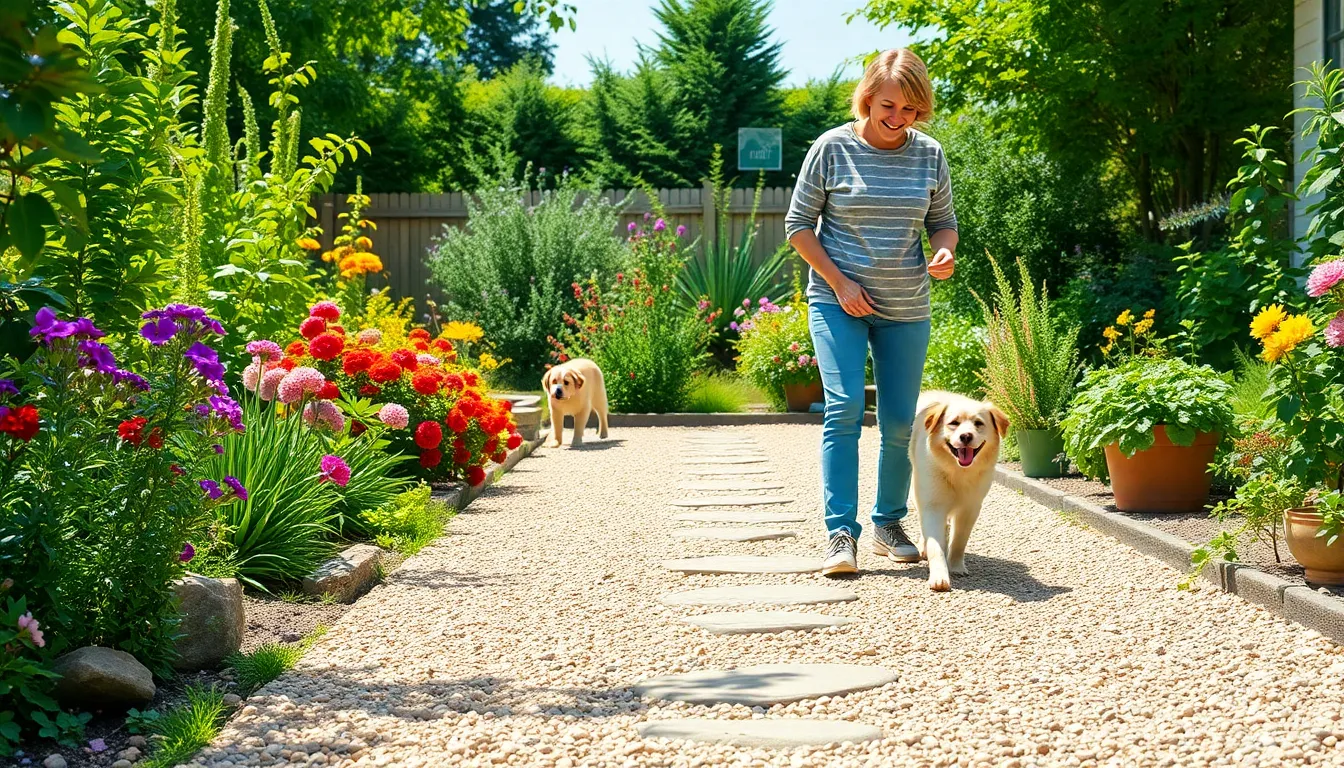
Creating effective pathways ensures our garden remains beautiful while accommodating our furry friends’ daily adventures. We’ll build routes that handle constant paw traffic without compromising our industry’s integrity.
Use Gravel or Stone for High-Traffic Areas
Gravel pathways provide the most resilient surface for areas where our dogs run, play, and exercise daily. Stone materials resist wear from digging and running while requiring minimal maintenance throughout the seasons. These surfaces drain efficiently and prevent muddy paw prints from tracking into our homes.
Natural stones like flagstone or decomposed granite create stable walking surfaces that stay cool under our dogs’ feet. We can choose from various colors and textures to match our garden’s aesthetic while ensuring non-toxic materials. Compacted gravel paths cost less than solid stone options but deliver similar durability benefits.
Install Stepping Stones Through Garden Beds
Stepping stones protect our delicate plants from soil compaction while giving our dogs clear navigation routes. Placing these stones strategically through flower beds prevents trampling and creates designated pathways for curious pets. Dogs naturally follow established routes when we provide obvious stepping points.
Flat stones spaced at comfortable intervals encourage our pets to use designated paths instead of cutting through plant areas. We should position stones approximately 18 to 24 inches apart to accommodate different dog sizes and gaits. This spacing works especially well in areas where our dogs frequently chase toys or patrol their territory.
Create Wide Walkways for Easy Navigation
Pathways measuring at least three feet wide allow comfortable movement for both dogs and owners during garden activities. Wide walkways prevent congestion when multiple dogs use the same route and reduce the temptation to venture into planted areas. Our pets prefer spacious paths that don’t restrict their natural movement patterns.
Generous pathway widths accommodate dogs of all sizes while leaving room for garden maintenance activities. We can use these wider spaces for wheelbarrows, garden tools, and comfortable walking during daily garden care routines. Broad pathways also create visual balance in our industry design while serving practical functions.
Install Secure Fencing and Boundaries
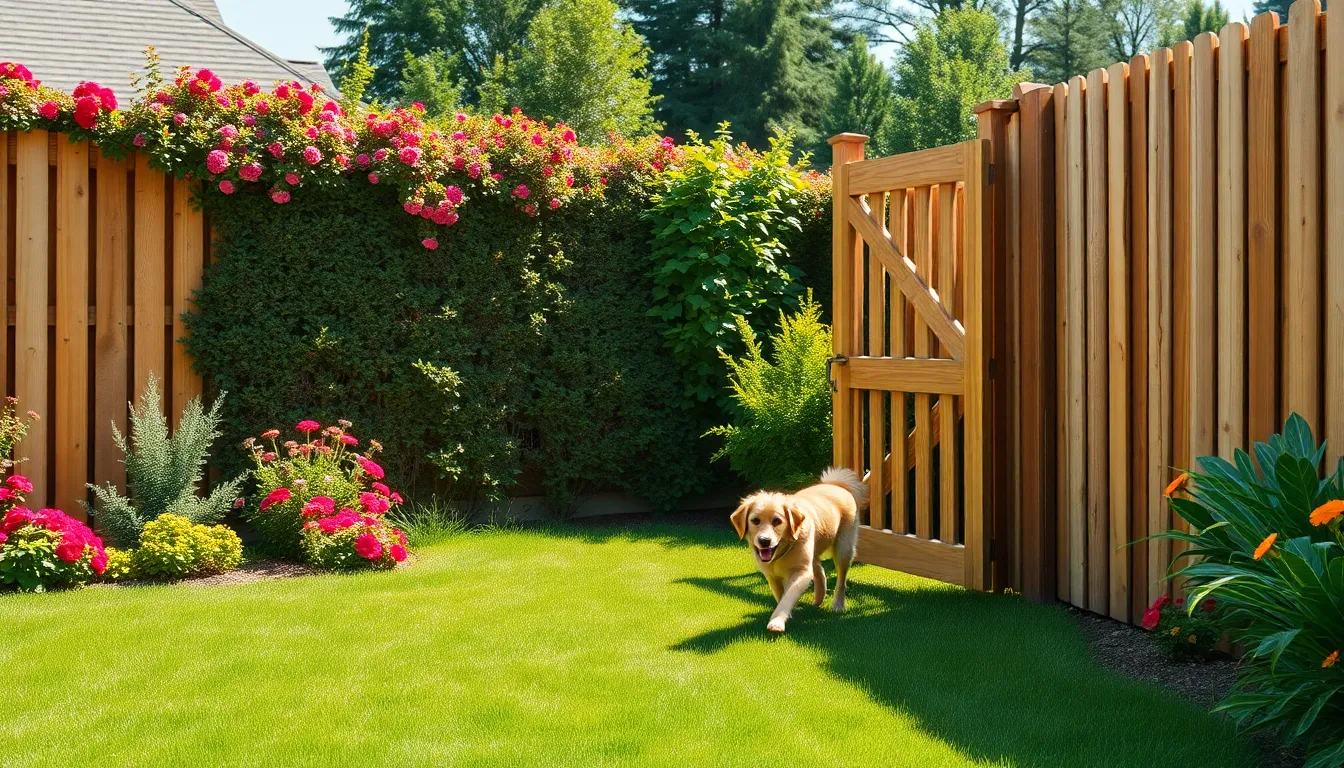
Creating physical boundaries protects our dogs while maintaining the garden’s beauty. Proper fencing prevents escapes and gives us peace of mind when our pets explore outdoors.
Choose Appropriate Fence Height for Your Dog’s Size
Fence height varies significantly based on your dog’s breed and jumping ability. Small dogs like Chihuahuas and Pugs typically need 4-foot fencing, while medium breeds such as Border Collies require 5-foot barriers. Large breeds including German Shepherds and Golden Retrievers need 6-foot fencing to prevent jumping escapes.
Consider your dog’s athletic ability when selecting fence materials. Active breeds like Jack Russell Terriers can clear surprisingly tall obstacles even though their small size. Assess your dog’s current jumping height by observing their play behavior and add 2 feet to that measurement for safety.
Sturdy materials like wood, metal, or vinyl provide the most reliable containment. Wood fencing offers natural aesthetics but requires regular maintenance to prevent rot and damage. Metal options like aluminum or steel deliver superior durability with minimal upkeep requirements. Vinyl fencing combines weather resistance with easy cleaning, making it ideal for busy households.
Add Garden Gates for Controlled Access
Secure gates prevent accidental escapes while providing convenient entry points. Install self-closing hinges and reliable latching mechanisms to ensure gates remain closed even during busy garden activities. Position gates strategically near high-traffic areas like patios and garden tool storage locations.
Choose gate materials that match your existing fence design. Coordinate colors and textures to maintain visual consistency throughout your dog friendly garden space. Select hardware rated for outdoor use to prevent rust and deterioration over time.
Consider double-gate systems for larger dogs or multiple pets. Wide openings accommodate wheelbarrows and lawn equipment while preventing dogs from rushing through narrow spaces. Install locks or child-proof latches if your dogs have learned to manipulate standard gate hardware.
Use Natural Barriers Like Hedges
Dense hedges create attractive boundaries while serving as natural dog deterrents. Emerald Green Arborvitae grows quickly and maintains year-round coverage, providing privacy and containment. Plant hedges 3-4 feet apart to ensure proper growth spacing and eventual density.
Evergreen shrubs offer consistent barriers regardless of seasonal changes. Holly, boxwood, and privet maintain their foliage throughout winter months when deciduous options lose effectiveness. Choose thornless varieties to prevent injury during play or exploration activities.
Strategic hedge placement guides dogs toward designated pathways and play areas. Create natural corridors that direct traffic flow while protecting delicate garden sections. Maintain hedge height at 3-4 feet to discourage jumping while preserving sight lines for supervision purposes.
Establish Designated Play and Relief Areas
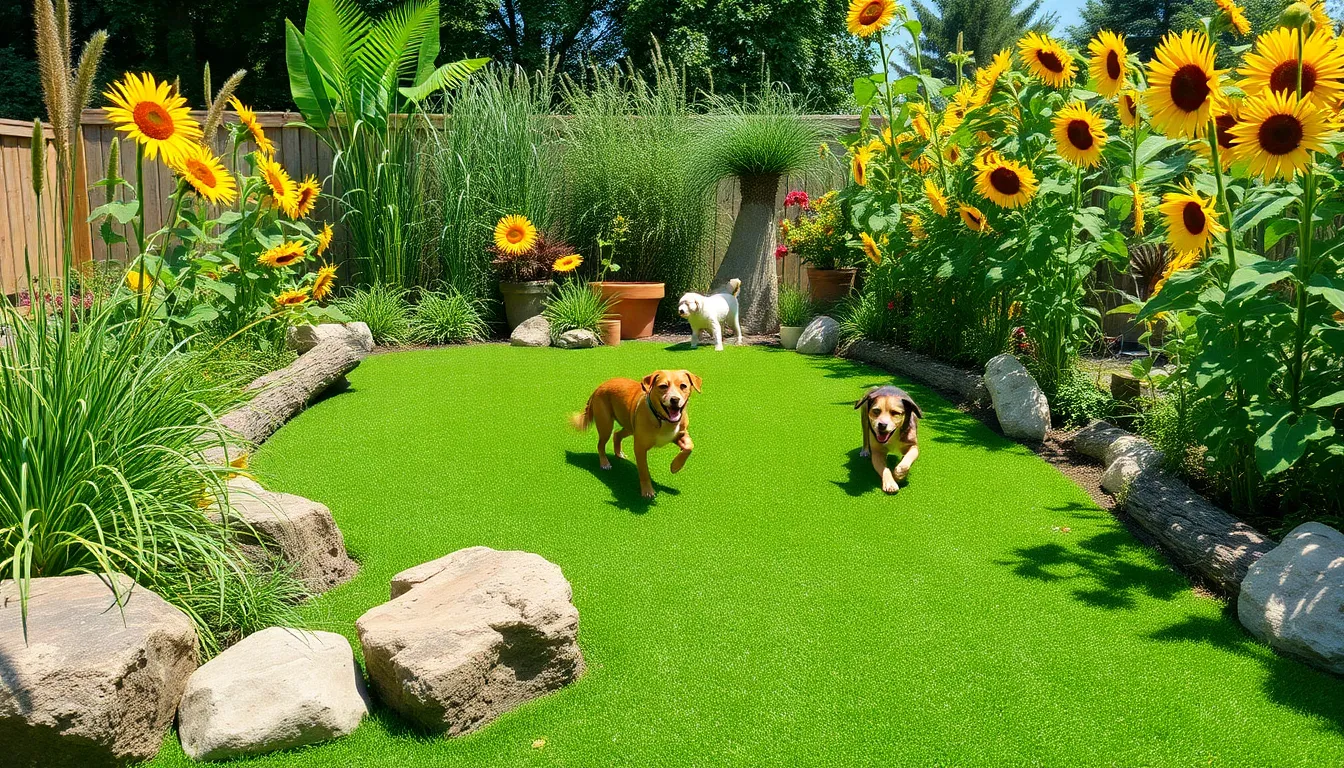
Creating exact zones for your dog’s activities helps maintain a beautiful garden while meeting your pet’s needs. We’ll show you how to design functional spaces that blend seamlessly with your overall industry design.
Create a Dedicated Dog Run Space
Design a fenced area specifically for running and playing to give your dog freedom while protecting your garden beds. This dedicated space should measure at least 200 square feet for small dogs and 400 square feet for larger breeds to provide adequate exercise room.
Use durable plants around the perimeter that can withstand constant traffic and occasional rough play. Ornamental grasses like fountain grass and feather reed grass create attractive borders while standing up to dog activity. Sunflowers planted along fence lines add vibrant color and grow tall enough to remain safe from most dogs.
Incorporate natural features such as logs and boulders for climbing and jumping activities. These elements provide mental stimulation and physical challenges that keep dogs engaged during outdoor time. Position these features away from fence lines to prevent escape attempts.
Install Artificial Turf for Easy Maintenance
Artificial turf eliminates muddy areas and provides a consistently clean surface for your dog’s play zone. This low maintenance option withstands heavy use better than natural grass while requiring minimal upkeep throughout the year.
Choose high quality pet exact turf with antimicrobial properties and proper drainage systems. Look for products with infill materials that prevent odors and allow easy cleaning with water and pet safe cleaners.
Install turf in high traffic areas where natural grass struggles to survive, such as entry points and favorite running paths. The synthetic surface maintains its appearance regardless of weather conditions or seasonal changes.
Designate Exact Bathroom Zones
Use materials like mulch or gravel in designated relief areas to make cleanup easier and more hygienic. These surfaces drain well and can be refreshed regularly to maintain cleanliness and odor control.
Select locations with good drainage away from outdoor entertaining spaces and vegetable gardens. Position these zones downhill from water sources and ensure easy access for daily maintenance routines.
Plant non toxic species nearby such as camellias or magnolias that can tolerate occasional soil changes and provide natural screening. These plants add beauty while creating privacy for both you and your neighbors during cleanup activities.
Incorporate Water Features for Hydration and Fun
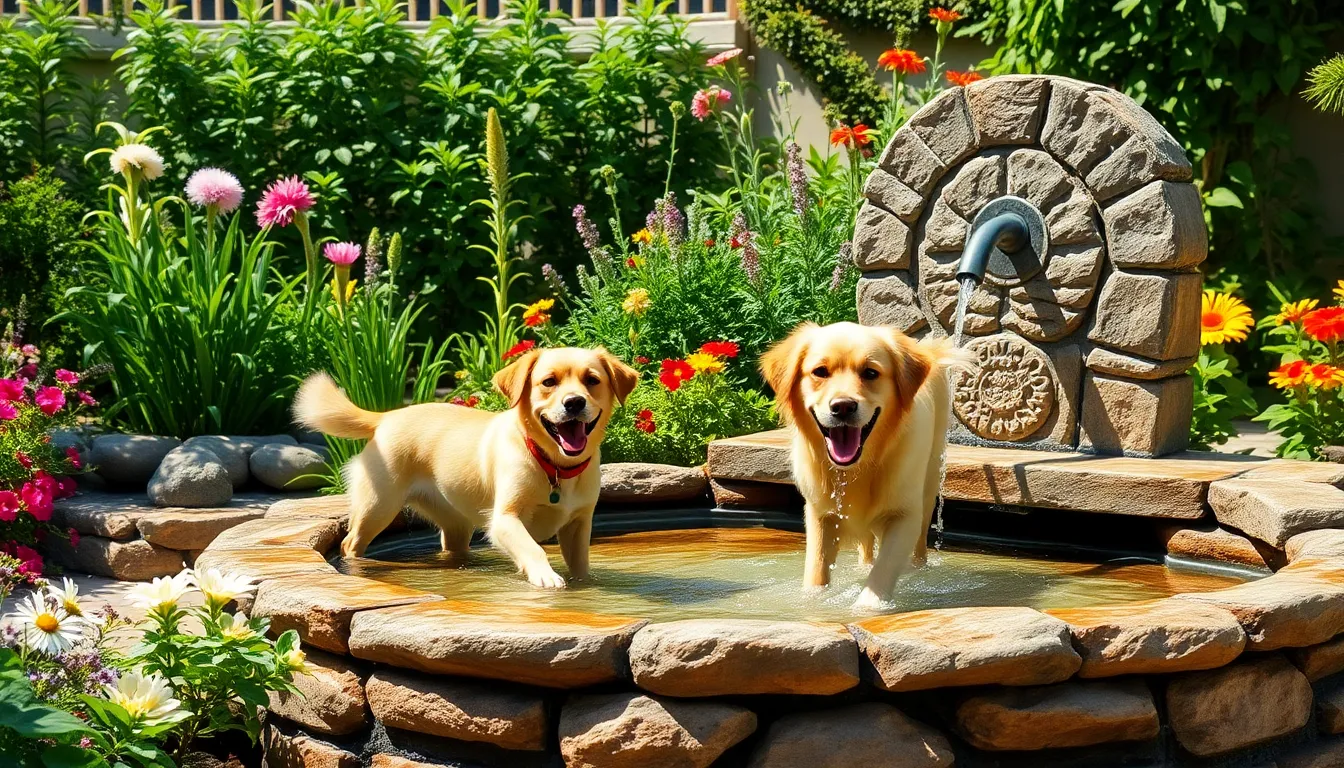
Water features serve as essential elements in dog-friendly gardens, providing both practical hydration answers and exciting recreational opportunities for our four-legged family members.
Add a Dog-Friendly Water Fountain
Installing a low-maintenance fountain creates an attractive focal point while ensuring our dogs have constant access to fresh, flowing water. Position the fountain at ground level or with a shallow basin that accommodates dogs of all sizes, from tiny terriers to large retrievers.
Choose fountains with sturdy construction that can withstand daily use and playful interactions. Solar-powered options eliminate the need for electrical connections while providing eco-friendly operation throughout the day.
The gentle sound of flowing water naturally attracts dogs and encourages regular drinking, which supports their overall health and well-being. Select models with easy-to-clean surfaces and replaceable filters to maintain water quality with minimal effort.
Install Shallow Splash Pools
Shallow splash pools offer perfect cooling answers during warm weather while creating interactive play spaces for active dogs. Design pools with depths of 6 to 12 inches to ensure safety for dogs of various sizes and swimming abilities.
Built-in splash pools using durable materials like concrete or fiberglass provide permanent answers that integrate seamlessly with garden design. Alternatively, portable kiddie pools offer flexible options that we can move or store as needed.
Position splash areas on level ground with proper drainage to prevent muddy conditions around the pool perimeter. Add non-slip surfaces or textured bottoms to prevent accidents during enthusiastic play sessions.
Ensure Easy Access to Fresh Water
Strategic placement of multiple water sources throughout the garden ensures our dogs stay hydrated during outdoor adventures. Install automatic water dispensers connected to existing irrigation systems for continuous fresh water supply.
Elevated water bowls work well for larger breeds while ground-level options accommodate smaller dogs and senior pets with mobility challenges. Stainless steel or ceramic bowls resist bacterial growth and withstand outdoor weather conditions better than plastic alternatives.
Create shaded water stations near play areas and resting spots to encourage frequent drinking during active periods. Regular cleaning and refilling of water containers prevents algae growth and maintains appealing taste for our canine companions.
Build Comfortable Shade and Shelter Options

Creating shaded retreats ensures our furry friends stay cool and comfortable during hot summer days. These shelter answers protect dogs from harsh weather while adding architectural interest to our garden design.
Install Pergolas or Gazebos
Pergolas provide excellent overhead coverage while maintaining an open, airy feel in our outdoor space. We can construct these structures using cedar or pressure-treated lumber that’ll withstand weather conditions and dog activity. Installing a pergola over a designated dog rest area creates an inviting spot where pets can relax without feeling enclosed.
Gazebos offer more comprehensive shelter from rain and wind than traditional pergolas. We recommend positioning these structures near our home’s entrance for easy access during storms. Adding dog-friendly climbing vines like grape vines or hardy kiwi to pergola posts creates natural decoration while providing additional shade coverage.
These overhead structures work particularly well when combined with comfortable outdoor furniture or dog beds underneath. We can enhance the space with hanging planters filled with pet-safe herbs like basil or mint that’ll naturally repel insects.
Plant Trees for Natural Shade
Strategic tree placement creates natural cooling zones that benefit both dogs and our entire industry. Camellias, magnolias, and Japanese maples provide excellent shade coverage without posing toxicity risks to curious pets. These trees also add seasonal interest through their blooms and foliage changes throughout the year.
Fast-growing options like red oak or tulip trees establish shade coverage more quickly for impatient pet owners. We should plant shade trees at least 15 feet from our home’s foundation to prevent root damage while ensuring adequate coverage for outdoor dog areas.
Consider the mature size of each tree species when planning placement around play areas and pathways. Fruit trees like apple or pear varieties offer shade plus seasonal treats, though we’ll need to clean up fallen fruit regularly to prevent stomach upset in dogs.
Add Dog Houses or Covered Rest Areas
Purpose-built dog shelters provide essential protection during extreme weather conditions. We recommend choosing elevated dog houses that promote air circulation and prevent moisture buildup underneath. Cedar or composite materials resist weather damage while naturally repelling insects that might bother our pets.
Position covered rest areas in corners of our garden where dogs naturally seek security and can observe their territory. These shelters should face away from prevailing winds while maintaining visual connection to our home’s main activity areas.
Portable shelter options like pop-up canopies or shade sails offer flexibility for seasonal use or special events. We can easily relocate these temporary structures based on sun patterns or garden maintenance needs throughout the growing season.
Built-in bench seating with overhead coverage serves dual purposes by providing shelter for dogs while creating comfortable observation spots for their owners. Adding storage compartments beneath these structures keeps dog toys and supplies easily accessible during outdoor playtime.
Choose Low-Maintenance Ground Cover Solutions

Ground cover answers form the foundation of any successful dog friendly garden, providing durability while reducing your maintenance workload. We’ll explore three proven approaches that create beautiful outdoor spaces capable of withstanding daily pet activities.
Plant Dog-Resistant Grass Varieties
Bermuda grass stands out as one of the most resilient options for dog friendly gardens, tolerating heavy foot traffic and recovering quickly from wear patterns. This variety thrives in warm climates and can handle the constant running, digging, and playing that active dogs bring to outdoor spaces.
Zoysia grass offers exceptional durability with its dense growth pattern that naturally resists damage from pet activities. We’ve found this variety particularly effective in areas where dogs frequently run the same routes, as it bounces back from compaction better than traditional lawn grasses.
Both varieties require less frequent overseeding compared to standard grass types, making them ideal choices for busy pet owners who want beautiful lawns without constant maintenance demands.
Use Mulch in High-Wear Areas
Organic mulch provides excellent protection for garden beds while creating clean pathways that reduce mud tracking throughout your outdoor space. Cedar chips, pine needles, and shredded bark work particularly well in areas where dogs regularly walk or rest.
Rubber mulch offers superior longevity in high traffic zones, maintaining its appearance and protective qualities even under constant pet activity. This option eliminates concerns about dogs ingesting organic materials while providing consistent ground coverage.
Strategic mulch placement around trees, along fence lines, and in designated relief areas keeps soil intact and prevents the formation of muddy patches that dogs often create through repeated use.
Install Permeable Hardscaping Materials
Permeable pavers allow water drainage while creating stable surfaces that won’t shift under active dogs’ movements. These materials come in various colors and textures, enabling you to design attractive pathways that complement your garden’s aesthetic while serving practical purposes.
Gravel installations provide excellent drainage and reduce puddle formation that can create messy conditions for both pets and owners. We recommend using rounded gravel rather than sharp edged varieties to protect your dog’s paw pads during extended outdoor play sessions.
Decomposed granite creates smooth, compactable surfaces that dogs find comfortable for running and playing while requiring minimal ongoing maintenance compared to traditional concrete or asphalt options.
Create Engaging Sensory Garden Elements

Sensory elements transform our dog-friendly gardens into interactive environments that stimulate our pets’ natural instincts. We can incorporate various features that appeal to our dogs’ senses of smell, touch, and sight while maintaining an aesthetically pleasing industry.
Plant Aromatic Herbs Dogs Can Enjoy
Aromatic herbs create a fragrant paradise that both we and our dogs can appreciate safely. Mint provides a refreshing scent that dogs find intriguing and can be contained in raised beds to prevent spreading. Lemongrass offers a citrusy aroma that naturally repels insects while remaining completely non-toxic to our pets.
We should position these herbs near pathways where dogs frequently walk to maximize their sensory experience. Rosemary adds Mediterranean charm to our gardens while providing a woody fragrance that dogs can explore safely. Organically grown herbs ensure our pets won’t encounter harmful pesticides or chemicals during their garden adventures.
Add Different Textures for Exploration
Different textures provide tactile stimulation that keeps our dogs engaged during outdoor exploration. Mulch paths create soft surfaces for paws while directing traffic flow away from delicate plantings. We can establish these pathways using cedar or pine mulch that feels pleasant underfoot and naturally decomposes over time.
Ornamental grasses introduce movement and varied textures that dogs love to investigate and brush against. Fountain grass and feather reed grass create gentle rustling sounds in the breeze while providing safe tactile experiences. Stone surfaces offer cool resting spots during warm weather and create interesting contrasts with softer garden elements.
Include Interactive Garden Features
Interactive features encourage natural behaviors and provide entertainment for our active dogs. Railway sleepers create elevated platforms that serve as natural benches for dogs to survey their territory from different vantage points. We can arrange these wooden elements to form steps or platforms that accommodate dogs of various sizes.
Water features enhance the sensory experience while providing practical benefits for our pets. Shallow pools or dog water fountains offer cooling opportunities and encourage hydration during playtime. Boulders positioned strategically throughout the garden create climbing opportunities and natural obstacle courses that promote physical activity and mental stimulation.
Implement Proper Drainage Systems
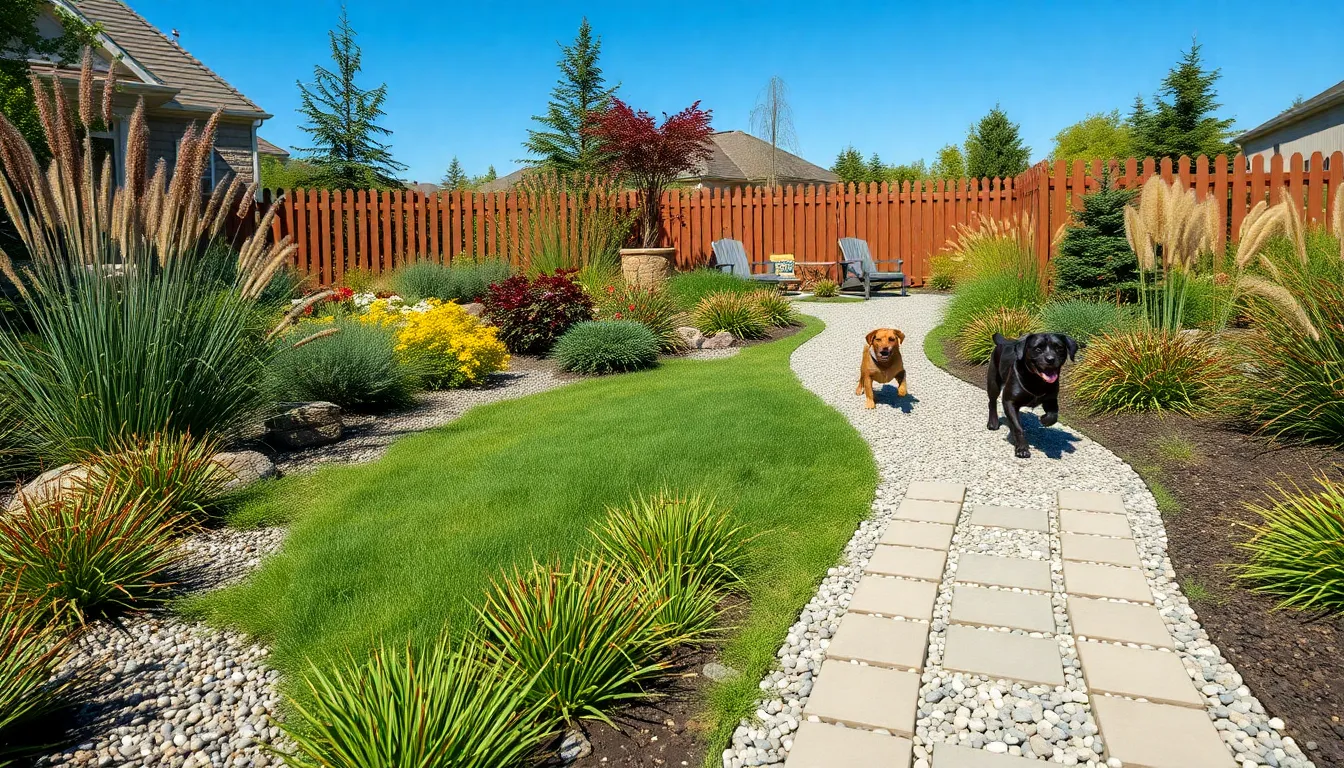
Effective drainage keeps our gardens safe and comfortable for our dogs while preventing water damage to landscaping features. Poor drainage creates muddy conditions that track into homes and can harbor bacteria harmful to pets.
Install French Drains in Problem Areas
French drains solve persistent water accumulation issues in areas where our dogs spend the most time. We recommend installing these drainage systems in low-lying spots where water naturally collects after rain or irrigation. The system consists of a perforated pipe surrounded by gravel and wrapped in industry fabric to filter debris.
Professional installation typically costs between $1,200 to $5,000 depending on the length and complexity of the drainage area. We’ve found that targeting problem zones near play areas and pathways provides the greatest benefit for active dogs. French drains work continuously to redirect water away from the surface, preventing the formation of puddles where dogs might drink contaminated water or track mud.
Create Sloped Surfaces for Water Runoff
Proper grading ensures water flows away from high-traffic areas where our dogs play and exercise. We design surfaces with a minimum slope of 2% (2 inches of drop per 100 feet) to help effective water movement. This gentle grade prevents erosion while encouraging steady drainage toward designated collection points.
Strategic sloping works particularly well around dog runs, pathways, and rest areas where standing water poses the biggest problems. We shape the industry to direct runoff toward planted areas that can absorb moisture naturally, such as rain gardens with dog-safe plants like ornamental grasses. Proper grading also prevents water from pooling against structures like dog houses or storage sheds.
Use Permeable Materials to Prevent Puddle Formation
Permeable pavers allow water to seep through surfaces instead of creating standing water that attracts insects and bacteria. We install these materials in high-traffic zones where traditional surfaces would become muddy and slippery. Permeable concrete and interlocking pavers provide stable footing for dogs while managing water absorption effectively.
Gravel pathways offer another excellent option for areas where our dogs run frequently, allowing immediate drainage while providing comfortable surfaces for paws. Decomposed granite works exceptionally well for dog runs and play areas, compacting into a solid surface that still permits water infiltration. These materials require minimal maintenance compared to traditional hardscaping while delivering superior drainage performance that keeps our gardens dry and our dogs healthy.
Plan Strategic Storage for Dog Supplies
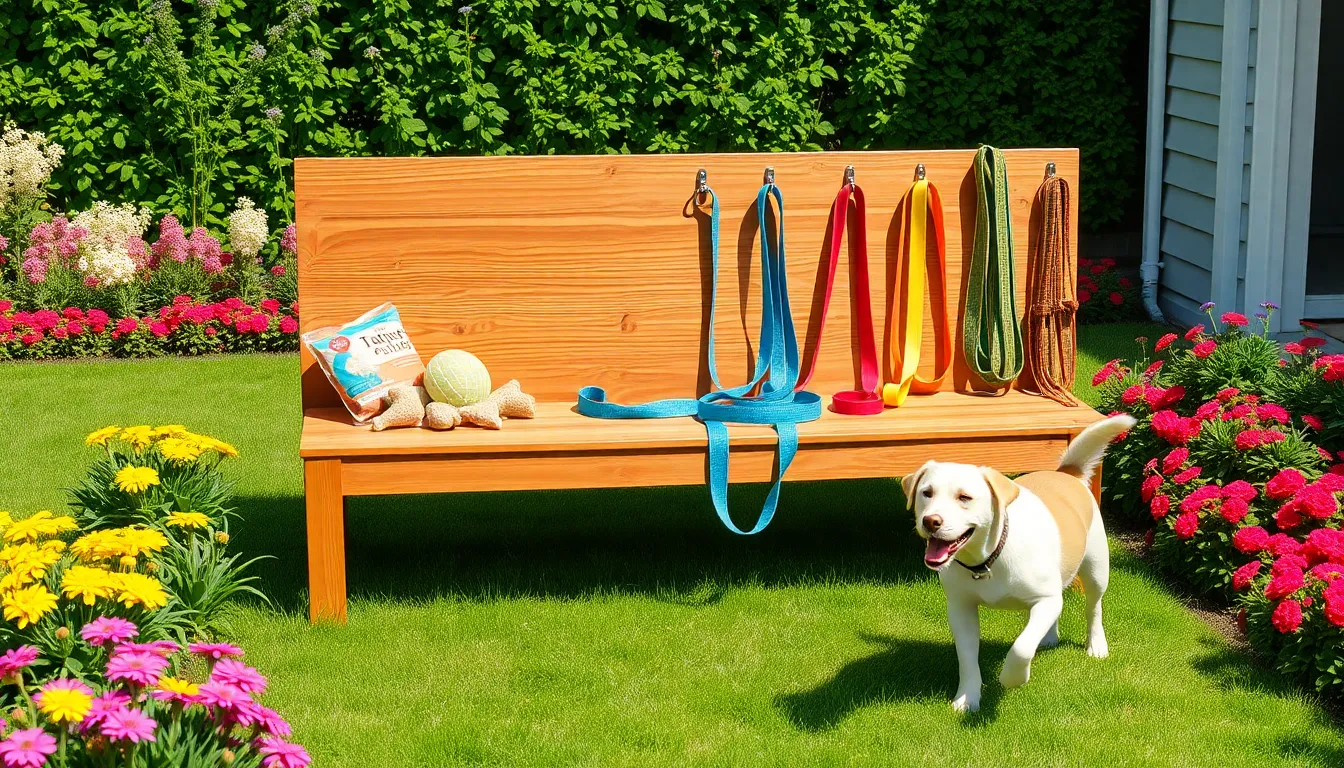
Organizing our dog’s outdoor essentials becomes effortless when we incorporate smart storage answers into our garden design. These strategic additions keep supplies accessible while maintaining our garden’s visual appeal.
Build Weather-Resistant Storage Benches
Weather-resistant storage benches serve dual purposes by providing comfortable seating while keeping our dog supplies dry and organized. Cedar and pressure-treated lumber offer excellent durability against outdoor elements, ensuring our investment lasts for years. We can customize these benches with waterproof hinges and weatherstripping to create completely sealed compartments for storing toys, training treats, and grooming supplies.
Building these benches with removable cushions allows us to easily clean and maintain them throughout different seasons. Strategic placement near our dog’s primary play areas ensures quick access to supplies during training sessions or playtime. We should consider adding interior dividers to separate different types of supplies and prevent smaller items from getting lost among larger toys.
Install Hooks for Leashes and Toys
Hooks near entry points keep leashes and toys tidy while ensuring they’re always within reach when we need them. Heavy-duty stainless steel hooks resist rust and corrosion, making them ideal for outdoor installation on fence posts, pergola beams, or dedicated storage walls. We can install multiple hooks at varying heights to accommodate different sized leashes and toys.
Creating a designated hook station near our garden entrance eliminates the frustration of searching for misplaced leashes before walks. Weather-resistant mounting hardware ensures these hooks remain secure even during strong winds or storms. We should space hooks at least 6 inches apart to prevent tangling and allow easy access to individual items.
Create Hidden Storage for Waste Bags
Hidden storage for waste bags maintains a clean and neat environment while keeping these essential supplies readily available during outdoor activities. Built-in dispensers can be incorporated into fence posts, storage benches, or decorative garden structures without disrupting our industry design. We can install weatherproof containers that protect bags from moisture while providing easy one-handed access.
Concealed storage options include hollow decorative posts or false-bottom planters that blend seamlessly with our garden’s aesthetic. Strategic placement along walking paths ensures we never find ourselves unprepared during cleanup duties. We should consider installing multiple hidden dispensers throughout larger properties to maintain convenient access from any location in our dog-friendly garden.
Conclusion
Creating a dog-friendly garden doesn’t mean compromising on beauty or functionality. We’ve shown you how thoughtful planning and smart design choices can transform your outdoor space into a paradise that both you and your furry friends will love.
From selecting pet-safe plants to installing proper drainage systems and storage answers your garden can become a safe haven for exploration and play. The key lies in understanding your dog’s needs while maintaining the aesthetic appeal you desire.
With these strategies in place you’ll enjoy watching your pets thrive in their custom outdoor environment while you relax in a beautifully designed space that serves everyone’s needs perfectly.
Frequently Asked Questions
What plants are safe for dogs in my garden?
Safe plants for dog-friendly gardens include marigolds, sunflowers, thornless roses, camellias, and magnolias. Aromatic herbs like mint and lemongrass are also excellent choices. Always avoid toxic plants such as azaleas, lilies, and sago palms, which can be harmful or fatal to dogs if ingested.
How much space do I need for a dedicated dog play area?
For a dedicated dog run, allocate at least 200 square feet for small dogs and 400 square feet for larger breeds. This provides adequate space for exercise and play while maintaining the rest of your garden’s beauty and functionality.
What ground cover works best for high-traffic dog areas?
Dog-resistant grass varieties like Bermuda and Zoysia grass are ideal as they tolerate heavy foot traffic and require less overseeding. For non-grass areas, consider organic mulch, rubber mulch, or permeable hardscaping materials like gravel and decomposed granite for durability.
How can I create proper drainage in my dog-friendly garden?
Install French drains in low-lying areas where water accumulates, create sloped surfaces for effective runoff, and use permeable materials to prevent puddle formation. This ensures a dry, healthy environment and prevents muddy conditions that dogs can track indoors.
What water features are suitable for dogs?
Low-maintenance fountains provide constant fresh water and can accommodate dogs of all sizes. Shallow splash pools offer cooling and interactive play opportunities. Position multiple water sources strategically throughout the garden to keep dogs hydrated during outdoor activities.
How do I protect valuable plants from my dog?
Install raised beds at appropriate heights to keep dogs away from delicate plants. Create designated pathways using stepping stones or durable materials like gravel to guide dogs along specific routes, protecting garden beds while maintaining easy navigation.
What shade options work best for dog-friendly gardens?
Install pergolas or gazebos using durable materials like cedar or pressure-treated lumber. Plant shade trees such as camellias and magnolias, add dog houses or covered rest areas, and consider portable options like pop-up canopies for flexible coverage.
How can I incorporate storage solutions in my dog garden?
Build weather-resistant storage benches that provide seating while keeping supplies dry. Install hooks for leashes and toys, and create hidden storage for waste bags. These solutions maintain organization without disrupting your garden’s aesthetic appeal.

